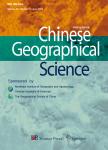Urban Agglomeration Formation and Its Spatiotemporal Expansion Process in China: From the Perspective of Industrial Evolution
Urban Agglomeration Formation and Its Spatiotemporal Expansion Process in China: From the Perspective of Industrial Evolution作者机构:Institute of Geographic Sciences and Natural Resources ResearchChinese Academy of SciencesBeijing 100101China Col-laborative Innovation Center for Geopolitical Setting of Southwest China and Borderland DevelopmentKunming 650500China College of Resources and EnvironmentUniversity of Chinese Academy of SciencesBeijing 100049China School of Public AdministrationInner Mongolia UniversityHohhot 010070China
出 版 物:《Chinese Geographical Science》 (中国地理科学(英文版))
年 卷 期:2020年第30卷第3期
页 面:532-543页
核心收录:
学科分类:0303[法学-社会学] 02[经济学] 0202[经济学-应用经济学] 020202[经济学-区域经济学] 0708[理学-地球物理学] 0705[理学-地理学] 0813[工学-建筑学] 0704[理学-天文学] 0833[工学-城乡规划学]
基 金:Under the auspices of National Natural Science Foundation of China(No.41801149) the Strategic Priority Research Program of the Chinese Academy of Sciences(No.XDA19040401) Young Talents of Science and Technology in Universities of Inner Mongolia(No.NJTY-20-B09) Key Laboratory of Regional Sustainable Development Modeling,Institute of Geographic Sciences and Natural Resources Research,Chinese Academy of Sciences(No.KF2018-05)。
主 题:urban agglomeration expansion mechanism industry Beijing-Tianjin-Hebei Yangtze Delta
摘 要:Urban agglomeration research has received increasing attention in China’s national development strategies, and has become a hot topic in academic research. This study develops a theoretical framework that explores the formation mechanism and expansion process of urban agglomerations from the perspective of industrial evolution, and identifies the development issues and their causes by taking Yangtze Delta and Beijing-Tianjin-Hebei urban agglomerations as case studies. In the process of urban agglomeration formation within a free market, as has happened in Yangtze Delta region, the central city develops first, its secondary industry is then transferred to its neighboring cities, and the work division and cooperation with the neighboring cities is gradually established. However, in the 1990 s, aiming to become an international metropolis, Beijing implemented a series of administrative policies to encourage the reduction of the secondary industry and the development of the tertiary industry, before its secondary industry were fully developed and transferred to its neighboring cities. This delayed the integration process and the development of the Beijing-Tianjin-Hebei urban agglomeration. This study builds a good foundation for the construction of the theoretical system’s urban agglomeration study, and provides references for decision making in an urban agglomeration development.



